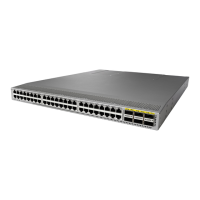Send document comments to nexus3k-docfeedback@cisco.com
9-8
Cisco Nexus 3000 Series NX-OS Unicast Routing Configuration Guide, NX-OS Release 5.0(3)U1(1)
Chapter 9 Configuring Layer 3 Virtualization
Configuring VRFs
BEFORE YOU BEGIN
Assign the IP address for an interface after you have configured the interface for a VRF.
SUMMARY STEPS
1. configure terminal
2. interface interface-type slot/port
3. vrf member vrf-name
4. ip-address ip-prefix/length
5. (Optional) show vrf vrf-name interface interface-type number
6. (Optional) copy running-config startup-config
DETAILED STEPS
Command Purpose
Step 1
configure terminal
Example:
switch# configure terminal
switch(config)#
Enters configuration mode.
Step 2
interface
interface-type slot/port
Example:
switch(config)# interface ethernet 1/2
switch(config-if)#
Enters interface configuration mode.
Step 3
vrf member
vrf-name
Example:
switch(config-if)# vrf member
RemoteOfficeVRF
Adds this interface to a VRF.
Step 4
ip address
ip-prefix/length
Example:
switch(config-if)# ip address
192.0.2.1/16
Configures an IP address for this interface. You must
do this step after you assign this interface to a VRF.
Step 5
show vrf
vrf-name
interface
interface-type number
Example:
switch(config-vrf)# show vrf Enterprise
interface ethernet 1/2
(Optional) Displays VRF information.
Step 6
copy running-config startup-config
Example:
switch(config)# copy running-config
startup-config
(Optional) Saves this configuration change.

